Quick Links
Even if your site follows SEO best practices to the letter – you may still have a hard time ranking #1 if your website lacks one crucial ingredient: domain authority.
Since Google only wants to rank trusted websites that provide accurate information, it uses backlinks (links from other sites pointing to your web pages) to determine the ‘authority’ of domains.
In particular, Google looks for links from websites that it already considers authoritative, like educational institutions, medical journals, legacy media sites, and trusted industry websites that have already built authority through their own SEO efforts.
This means you’ll need to generate lots of backlinks from websites that Google already trusts to pass authority back to you (trust by association, so to speak).
The proof?
The top Google result contains an average of 3.8x more high-quality backlinks than positions #2 – #10.
Also, countless experiments and campaigns have proved the effectiveness of acquiring high-authority backlinks for better SERP (search engine results pages) rankings.
But what is domain authority? Will keeping track of it help your SEO? Is it actually something Google uses to rank websites?
These are the questions we’re going to answer today, so stay tuned.
In this article, we’ll take a closer look at:
⭐️ What domain authority is and why it’s useful
⭐️ How to check your website’s DA
⭐️ Strategies to boost your DA score to improve your chances of ranking on the first page of Google.
The History of Domain Authority (PageRank)
First, it’s crucial to note that the domain authority metric we’re about to discuss is different from the actual domain authority formula that Google uses – which is called PageRank.
Wait, what?
Back in the day (around the year 2000), Google’s PageRank algorithm, which ranks web pages based on the number and quality of backlinks they have, featured public data.
It was available through the Google toolbar (which has since been discontinued entirely in 2021), and it served as a source of obsession for digital marketers at the time.
The PageRank toolbar would provide a simple 1 – 10 score for how ‘important’ Google thought the page was (in other words, how likely it was to rank for its target keyword). This 1 – 10 score was the first iteration of domain authority, and those pesky black hat SEOs are responsible for its demise.
Since Google’s domain authority data was public, it was very easy for search engine optimizers to use spam tactics to manipulate the results. Since PageRank was public, they could monitor the success of their efforts in real time.
Excessive spamming became such a problem that Google removed PageRank from the Google toolbar in 2016, and the data is now private.
Since a domain’s ranking power on Google became a mystery, SEOs have developed substitute metrics that mimic PageRank.
Moz’s domain authority score
That brings us to domain authority, which is a third-party SEO metric first developed by SEO software company Moz. It represents how likely a domain is to appear in the SERPs over its competitors.
First rearing its head in 2004, Moz’s domain authority (DA) goes a bit more in-depth than Google’s PageRank toolbar.
For one, it’s a score from 1 – 100, with 100 being the strongest and 1 being the weakest level of authority. Also, Moz looks at ranking factors besides backlinks when calculating domain authority (more on these below).
As a result, Moz’s domain authority is more of an all-inclusive representation of a domain’s SEO performance, whereas PageRank only looks at the number and quality of backlinks.
Yet, as we know, Google has more than 200 ranking factors, which include many that Moz uses in its domain authority calculations. That’s why checking a domain’s authority score is considered the most accurate judge of its ranking power.
If there’s another website you can’t seem to outrank, Google probably considers them more authoritative – so don’t forget to check their domain authority score.
Domain authority isn’t something that you can improve overnight, but airtight on-page SEO practices and a winning link-building strategy will help you improve your DA score.
While your SEO strategy shouldn’t revolve around building domain authority, it is a reliable metric for judging the likelihood of your content appearing on the SERPs.
The concept of domain authority
As a concept, domain authority has been around since 1999 when it was mentioned in a paper by John Kleinberg called Authoritative Sources in a Hyperlinked Environment.
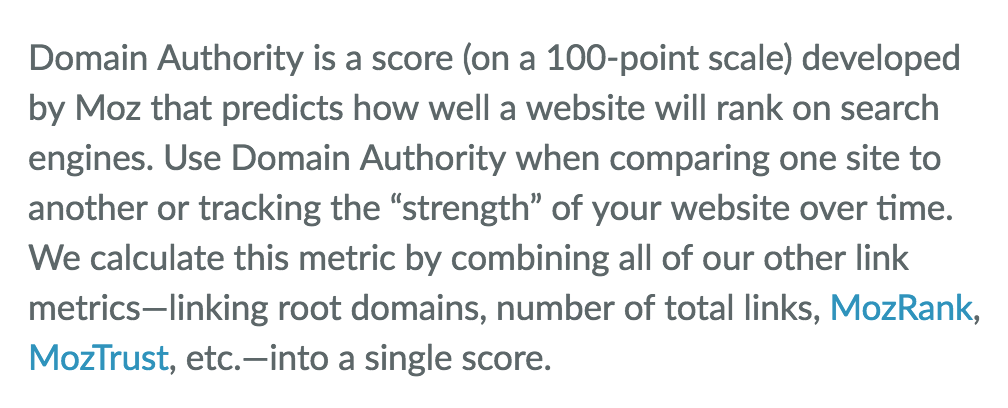
In it, Kleinberg asserts that search engines have an ‘abundance’ problem – where all the relevant results that could be returned for a query are too large for a human to digest.
Therefore, search engines need a way to filter the results so that only the most ‘authoritative’ or ‘definitive’ results remain.
That’s why the top-ranking results on Google are always the most trusted, highest-quality websites.
Which Factors Does DA Look At?
As stated before, Moz’s domain authority score considers lots of factors related to a website’s link profile and SEO performance to estimate its potential to rank on search engine results pages (SERPs).
While exact details are scarce, here are a few factors that impact your DA score:
- Linking root domains
- Social signals
- The age of a domain
- Total number of links
- Link quality
- Monthly organic traffic
- Internal link structure
- General SEO performance
- MozRank
- MozTrust
Linking root domains and a website’s total number of links are two of the strongest ranking signals related to your domain authority score.
Linking root domains: This refers to the number of unique domains linking to the website. More unique domains generally contribute to a higher DA.
Total number of links: The total number of inbound links to the website from external sources, including multiple links from the same domain.
In other words, the DA score is a reliable way to judge the strength of your link profile (and of your competitors) – which definitely matters for achieving better SERP rankings.
Machine learning
In addition to these factors, Moz also uses a machine learning algorithm that predicts how often Google will use a domain in its SERPs.
If domain A is determined to appear more in the SERPs than domain B, then it will have a higher domain authority score.
Since this machine learning algorithm is always at work (and users are performing searches 24/7), it’s common for DA scores to fluctuate often.
This algorithm looks at data that constantly changes, comparing your website with others.
For example, if Wikipedia were to acquire 100,000 new backlinks, everyone else’s DA score would drop.
Established domains like Wikipedia, Amazon, and Facebook have such massive link profiles that they tend to occupy the higher DA score slots (think of scores 80 to 100).
As a result, most small-to-medium-sized websites have average DA scores ranging from 10 to 60.
Also, it’ll be easier to raise your DA score from 20 to 30 than from 60 to 70. Moz recommends using Domain Authority (DA) scores to compare your website with similarly well-known ones.
This helps you understand where your site stands in comparison.
So, don’t fret if you can’t raise your DA score to 100, as that’s next to impossible for most businesses. Instead, ensure that your DA score is around the same or higher than your direct competitors.
If a competitor outranks you with a DA score of 56 and yours is 48, raising it to 60 should nudge you over the top.
Is domain authority an official Google ranking factor?
Speaking of using domain authority strictly as a comparative metric, it’s not an official Google ranking factor – and Moz will be the first to tell you this.
To quote their website directly, “Domain authority is NOT an official Google ranking factor and has no effect on the SERPs.”
Google’s John Mueller has also stated repeatedly that Google’s algorithms do not use domain authority as a metric when ranking websites.
Remember, Google’s official ‘domain authority’ calculation, the PageRank algorithm, is kept private to discourage spammers and link schemes.
Since it’s not an official ranking factor, why pay attention to your domain authority?
While Google’s ranking algorithms don’t use Moz’s exact domain authority formula, it’s no secret that things like backlinks, referring domains, search traffic, and user experience ARE Google ranking factors, and they comprise domain authority calculations.
As such, domain authority is a useful metric for comparing your site health and SEO-friendliness to your direct competitors – even though it’s not directly measured by Google.
How to use domain authority
Let’s say that your eCommerce store has a DA score of 50, and you’re only able to rank in position #2 for your target keyword.
After doing a little digging, you uncover that the website outranking you has a DA score of 58.
This is a strong indication that they have superior site health and a stronger backlink profile than you – which is why they’re currently outperforming you.
The good news is you can closely analyze their website and backlink profile to discover what they’re doing that you aren’t (more on this in a bit).
To summarize, digital marketers still pay attention to domain authority because it’s a quick and easy way to gauge the overall SEO-friendliness of a website.
You can think of your DA as the overall grade representing the strength of your SEO stats (i.e., organic traffic, referring domains, etc.).
Using it this way will help you gauge how much work it’ll take to bridge the gap between you and your competitors. If you’re only 8 points lower than a site you want to outrank, it shouldn’t take too much work to even the playing field.
Optimizing your existing content and acquiring a handful of high-authority links should boost your score enough to leave them in the dust.
Focus on Page Authority
SEO involves more than getting your homepage to rank; it’s also about snagging the #1 position for your most important web pages.
Your product pages, landing pages, and content pages all need adequate authority in order to rank for the keywords most important to your target audience.
This means you need a way to determine the ranking strength of each web page.
After all, you could have a decent DA, but if the authority of your most crucial product pages and blogs is less than optimal – you’ll be in trouble. While your homepage rakes in plenty of organic traffic, your ‘money’ pages will only see crickets and tumbleweeds.
Enter page authority (PA), a metric that lets you judge the ranking strength of any page on your website.
| Key point: What is Page Authority?
Page Authority (PA) is another metric developed by Moz that predicts the likelihood of a specific page ranking in search engine results pages (SERPs), scored on a scale from 1 to 100, where higher scores indicate a greater ability to rank. Unlike Domain Authority, which assesses the entire domain’s strength, Page Authority focuses on the ranking strength of a single page. |
Much like domain authority, it’s not an official Google ranking factor but instead serves as a score grading a page’s overall probability of ranking in a top spot.
⚠️ Important note: While page authority looks at crucial factors like the total number of links – it does not consider on-page SEO elements like keyword use or content optimization. That means you should only view a web page’s authority to gauge the strength of its backlink profile and ranking probability.
To evaluate your on-page SEO, use our free SEO Audit Tool instead. Not only will it let you know a website’s domain authority, but it also judges crucial metrics like keyword usage and user experience.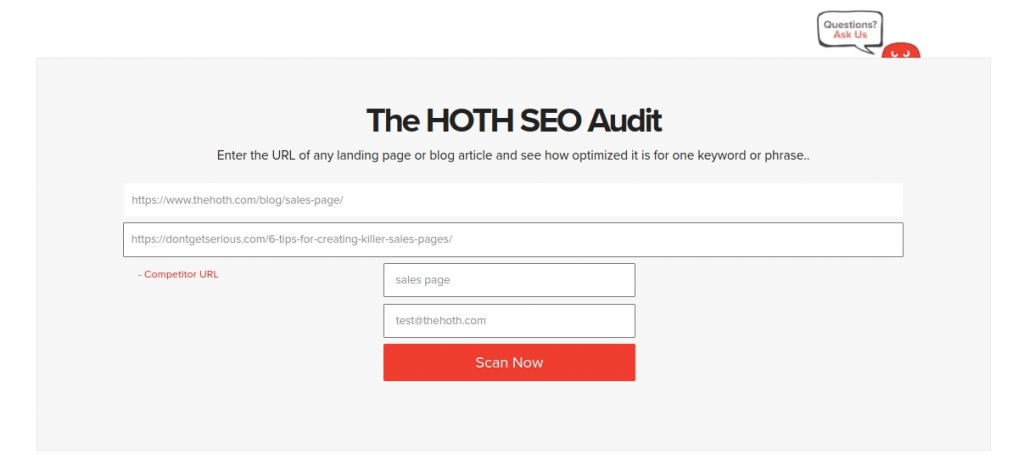
How Can You Check Domain Authority?
If you want to check your DA or a competitor’s DA score, you have plenty of options.
While Moz’s domain authority was the OG, plenty of other SEO companies have developed their own authority metrics in the years since, including:
- Ahrefs uses two metrics: Domain Rating (DR) and Ahrefs Rank (AR). Domain Rating is a comparative metric (like Moz’s DA) that compares the strength of a website’s backlink profile to others in Ahrefs’ database. AR ranks the websites in Ahrefs’ database according to the size and quality of their backlinks.
- SEMrush uses an Authority Score that measures the overall quality and performance of a domain or individual webpage. It’s less of a comparative metric and more of a straightforward gauge of your SEO-friendliness.
- Majestic’s Flow Metric Scores measure content quality and a website’s total number of links.
As you can see, each of these domain authority scores is a bit different.
We think Ahrefs is useful because you get both a comparative metric and a more straightforward one, whereas SEMrush is more about judging the quality of your SEO strategy.
In addition to these tools, our free SEO Checker Tool will provide an overview of an entire website or specific web page (including both DA and PA).
Techniques for Building Domain Authority
If your DA and PA scores are falling behind your competitors, it’s time to start building them back up.
Here’s a look at the most effective techniques for increasing domain authority.
Guest posting
If you want your DA score to rise, acquiring high-authority backlinks is key – and guest posts remain one of the best ways to snag them.
Guest posting involves finding relevant websites in your niche that accept guest posts and then contacting them with an article pitch.
If you want a snowball’s chance of securing a guest blog, your pitch needs to provide real value to the website’s target audience (which, if you’re playing your cards right, should align perfectly with your core audience).
Don’t try to regurgitate one of your existing blogs since it’s much better to create something brand-new. If you’ve got your heart set on increasing exposure for your blog’s ‘greatest hits,’ you’re better off pursuing article syndication instead.
True guest posting involves writing new posts specifically for the website in question, especially in terms of topic choice. You should select a topic that A) relates to one of your essential products or services and B) aligns with the guest website audience’s interests.
Let’s say that you sell gardening tools online, and you write a guest post for a gardening enthusiast’s blog.
This is perfect because the blog’s audience is adjacent to yours, but you aren’t directly competing for business. In other words, the gardening blog is only there to provide reading material for gardeners, and they aren’t selling any products that compete with yours.
That makes them the ideal candidate for a guest post. At the same time, you should select a topic that their audience would enjoy, such as how to prune roses (while including a backlink to your product page selling pruners).
How can you find guest post opportunities?
Google Search Operators are your best friend when looking for websites that accept guest posts in your field.
In particular, this formula works wonders:
Your niche keyword is “guest post.”
For instance, if you’re in the accounting industry, and looking for websites to guest post on, here are some search operators you could use:
Accounting “guest post”
Accounting “write for us”
Accounting “guest poster wanted”
Accounting “This post was contributed by.”
Besides using Google, you can also check out our extensive list of vetted guest post websites in need of fresh content.
The best part about our list is that all the websites were self-submitted, meaning they’re actively seeking guest posters.
Analyze competitor websites and backlink profiles
If you always seem to be a few steps behind one of your competitors on the SERPs, you should take a peek at their link profile to see what’s up.
Every website has a link profile, and there are plenty of tools online that make them visible.
Competitor link profiles can provide invaluable information for your SEO campaign. For instance, by analyzing a competitor’s link profile, you’ll be able to see where their top backlinks are coming from.
It could be a website they frequently guest post on, a directory you aren’t listed on yet, or a media outlet that they syndicate articles to.
Whatever the case may be, your competitors’ link profiles can provide you with lots of backlink opportunities that you may not have found otherwise.
You can use our free Backlink Checker Tool to view the backlink profile of any website on the internet (including yours).
When examining a competitor’s link profile, keep an eye out for the following things:
- Do you notice any guest posts?
- Are they listed in any directories that you aren’t?
- Do any ‘top 10 lists’ mention their products?
Also, just keep an eye out for any websites you think might want to link to your website.
In addition to looking for backlinks you can poach, you can also look for glaring weaknesses in their content.
For example, let’s say you pull up a competitor’s top-ranked blog posts and put them under a microscope.
You notice that they don’t explore the topic as fully as you can and that some of their information is false.
That prompts you to create an even more in-depth blog on the same topic containing accurate, up-to-date information – boosting your authority and outranking the competitor as a result.
Fix broken links
Broken link building is a good way to find chances to boost your Domain Authority (DA) scores. Here’s the simple approach:
- Use our Backlink Checker Tool to spot broken links on other sites.
- Make or find content on your site that can replace the missing link.
- Reach out to the website owner and suggest your content as a replacement.
Fixing broken links is a speedy way to acquire backlinks, especially if you already have a suitable replacement page ready to go.
Ensure optimal site performance
The strength of your backlink profile isn’t the only factor determining your domain authority score.
You also need to ensure that your website features a pleasant and engaging user experience.
What does that entail?
Quite a few things.
First, if you want to appear on Google’s SERPs, your website must pass the Core Web Vitals test.
It judges your website’s loading speed, including how long it takes for users to start interacting with your website.
If your page loads poorly, you’ll fail the test and won’t be able to rank. To find out if your loading times are up to snuff, you can use Google’s PageSpeed Insights.
Mobile responsiveness is another necessity for modern websites, and Google has used mobile-first indexing since 2017.
That means you’ll need a responsive website design to rank on the SERPs. Luckily, Google has another free tool to check your mobile friendliness, the Google Mobile-Friendly Test.
Final Takeaways: What is Domain Authority?
While domain authority and page authority aren’t official metrics that Google measures, they’re both one of the most reliable ways to judge the ranking power of a website or web page.
If your domain authority is lacking, you must improve your site’s performance and acquire more high-quality backlinks.
Do you need help improving the domain authority for your website?
Then don’t wait to check out our Link Outreach and Link Insertion Services from The HOTH.
Our link-building gurus have built stellar link profiles for countless clients, so don’t wait to get in touch.





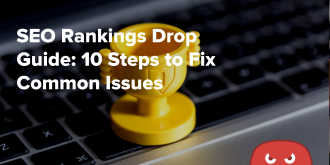


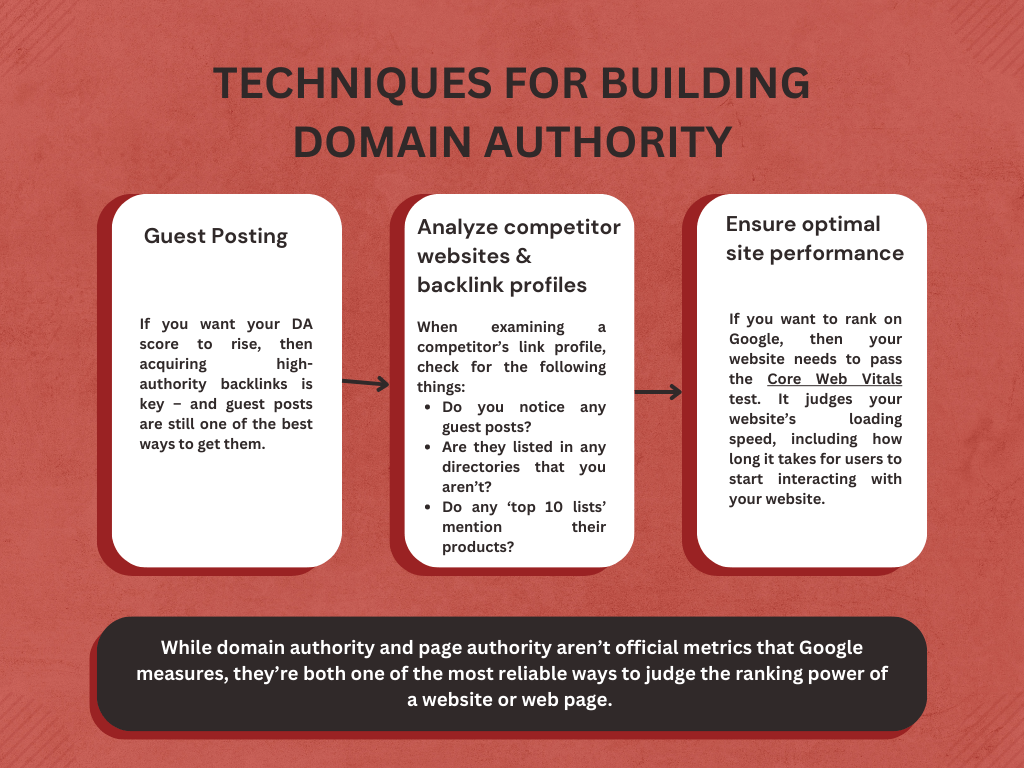

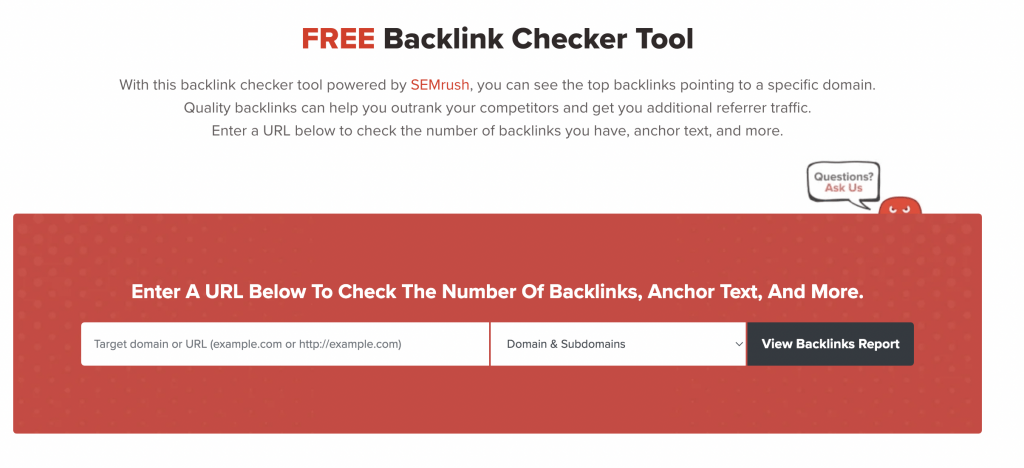
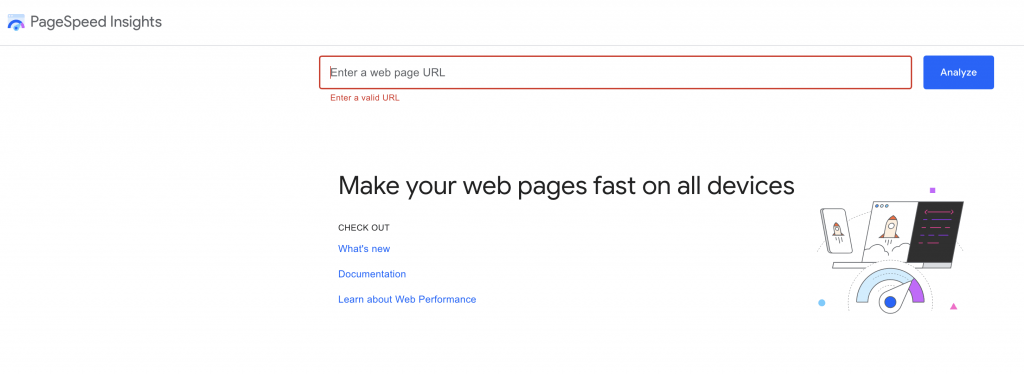


The most complete thing I read about domain authority
Glad you thought so, thanks!
Thanks for this valuable information and hope to see these types of information.
Regards.
I couldn’t agree more with seouser. This is an easy to understand and in-depth tutorial! Waow.
Awesome, thanks Eric 🙂
Valuable content.
Thanks for the information. Keep it up guys.
You’re welcome, cheers!
Awesome thanks
Nice Article. Do backlinks Increase domain authority as we see nowadays so-called Digital Marketers just focus on backlinks without seeing whether the links are dead or not? They just blindly waste their time and money into building links. What’s is your opinion?
Backlink quality is important. You need to check out the backlinks you’re acquiring to make sure they’re good and if so it can definitely help increase your domain authority.
Awesome article. Learning these knowledge of back-links i have done well in my clients website. Thanks for awesome post..hope I’m wondering again good article.
Thanks!
Great write up. I appreciate that you illustrate the difference between PR and DA. Another thing that I think you captured well is the necessity to explain that DA was developed by Moz. I find that even people who work in the industry don’t realize where DA comes from, they sometimes assume that this scoring comes directly from Google.
When comparing Ahrefs and Moz’s page and domain metrics do you see a clear winner? I keep tabs on both to add a bit of redundancy to my metrics (in case one doesn’t predict a big problem).
I think you’ve got it, keep tabs on both since they’re both pretty reliable. Both Ahrefs and Moz have huge link indexes that are very good, so it can’t hurt to look at both Moz DA and Ahrefs DR.
Very useful information about backlinks and DA.
Very regards.
Good to know we aren’t the only ones keeping tabs on a multitude of authority metrics! Typically they show some correlation but for now we don’t see a clear winner between PR/DA & Domain Rating/URL Rating.
Thanks for the article. Does The HOTH offer a domain authority improvement service?
Hi Gregg, we actually have multiple services that can help improve domain authority but aren’t referred to as “domain authority improvement” services by name:
Our main Link Building Service, our Guest Post service, and of course our managed SEO service HOTH X all involve work with the goal of increasing your domain’s authority. You can always reach out to us with further questions here.
Superb idea Sir.
Very very regards.
Hey Thanks a lot for sharing this information it will really help me improve my website domain authority.If anyone help to increase my website domain authority of my below website- https://www.limratechnosys.com/
What are the best ways to increase/improve domain authority for new websites and new blogger’s blogs? Will guest posting will help me increasing Domain authority? If yes then how to add value?
You can increase Domain Authority for new websites by Step 1: Publishing great, value-driven content on it. And Step 2: Doing direct outreach to other sites to get links to that content. To provide value, you should both think about and research what your niche’s audience cares about: what questions are they asking, what problems do they have that they need solved (by your content)? Guest posts are definitely one way to do it, but you can also build links by getting your content or site listed on resource pages, broken links, unlinked mentions, and a variety of other link building methods we cover in this article about SEO for brands and this one about backlinks.
thank you for your valuable article.
Hello “Hoth” such a great article on Domain Authority of the Website
that was really informative
thanks for sharing
Hey,
Domain authority is based on a lot of factors. Primarily, however, these are link profile factors such as how many backward links are pointing to your website and how authoritative those sites are.
It is very difficult to gain a DA number of 100. Sites like Facebook and Google have it, so don’t be disappointed if you never hit 100.
DA is difficult to influence directly. You can’t change your DA score like you can change your meta tags.
Check out the different benefits of SEO for the growth of your business.
· SEO helps to increase quality traffic to your company website
· The traffic generated by SEO is more likely to convert
· SEO increases your sales and leads
· It can reduce your cost per acquisition
· SEO does not include any paid advertising
Nice and important article. I hope to see more useful information about this.
Best regards.
Valuable information. It is the most important part in our ranking process.
Very very regards.
Awesome and helpful information and hope to see more these types of things.
Very regards.
very nice post i shared with freinds
Great article Glen!
Indeed there are many profitable niches out there waiting for curious minds to dominate them.
It is amazing how we cannot exhaust the available niches. Everyone has a chance. And for those who fail to succeed, it is because of their own foolishness.
Great work combining these statistics!
Thank you for valuable information.
Thanks for this detailed guide on Domain Authority! It offers valuable insights and practical tips for improving website rankings. The emphasis on actionable steps like guest posting is appreciated. A must-read for digital marketers!